|
|
CAPPADOCIA - TURKEY |
Goreme After the rather monotonous drive the last 200 miles before Goreme, we descended into a large valley with its limestone "sand dunes" and strange conical shaped spires, speckled with holes cut into the rock. |
We checked into our room at Elifstar Hotel, which was a cave cut into the rock! From our little balcony, the bewitching view of the strange exotic landscape was complimented by the colorful hot air balloons gently floating overhead. |
How the rock formations were made: The Cappadocia region is surrounded by 3 now dormant volcanoes, which 30 million years ago, erupted, covering the area with different layers of easily eroded volcanic ash called 'tuff'" overlain in places by layers of hard volcanic rock. With the passing time, the wind, rain and changing temperatures eroded the tuff to make incredible shapes. "Fairy Chimneys" were created by high projections of tufa, capped by the harder top layer of basalt. The basalt served to shelter the underlying soft tufa from the elements that wore away the stone. |
Ihlara Our journey continued south passing workers digging in potato fields and where we would sometimes need to stop for a herd of sheep or goats crossing the road. |
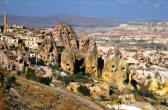 | 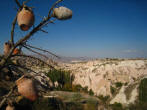 | Urgup The town of Urgup is full of stone homes left over from the pre 1923 days when it still had a large Greek population. In the hillsides surrounding the town are rock cut homes. | 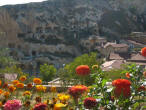 |
|
At Pasabag, near Zelvie, we stopped and wandered through an extensive and wondersome outcrop of spiralling dome-capped fairy chimneys. Spread over 3 valleys, Zelvie was inhabited until 1952. Now souvenir shops take advantage of the visiting tourists. | ||
|
There were quite a few churches to explore, some difficult to reach. The climb was rewarded by vistas of frescoes and decorations | ||
Around Goreme Town We had a full day of sightseeing and it was starting to get dark when we returned to Gorome. The town of Goreme is small and quaint with many little pensions scattered amidst the hilly surrounds. Lots of restaurants to choose from, but we soon found our favorite dig that served delicious borek and other Turkish delights by a very social cook and staff that soon became great friends. Bruce got right into party mode in the street to the beat of the Turkish music! | ||
A visit to a music shop ...and the boys dropping what they were doing to entertain us playing their Turkish instruments. |
October 8/08 When you live amid a landscape composed primarily of porous volcanic tufa, it doesn’t take long before you realize, “Hey, I could make a great house out of this stuff." | In fact many hotels, restaurants and pensions in Goreme are hollowed out of the rock. Some of the resort hotels are very high-class and expensive. |
An amazing example of the rock cut monasteries is the Kislar Monastery. Ladders were used to reach the upper levels. | Hiking Pigeon Valley Immediately behind our hotel was the beginning of the trail through the floor of Pigeon Valley that ended at Uchisar. The trail, more like an old creek bed, meandered through through vineyards, olive and fruit trees, and grape vines separated by stunning pinacles of fairy chimney rock and towing tufa cones. |
 |  | 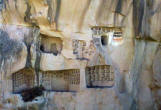 | 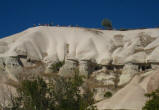 | |
The cliffs around were honeycombed with pigeon homes and secret entrances. led through a series of tunnels cut through the rock. | ||||